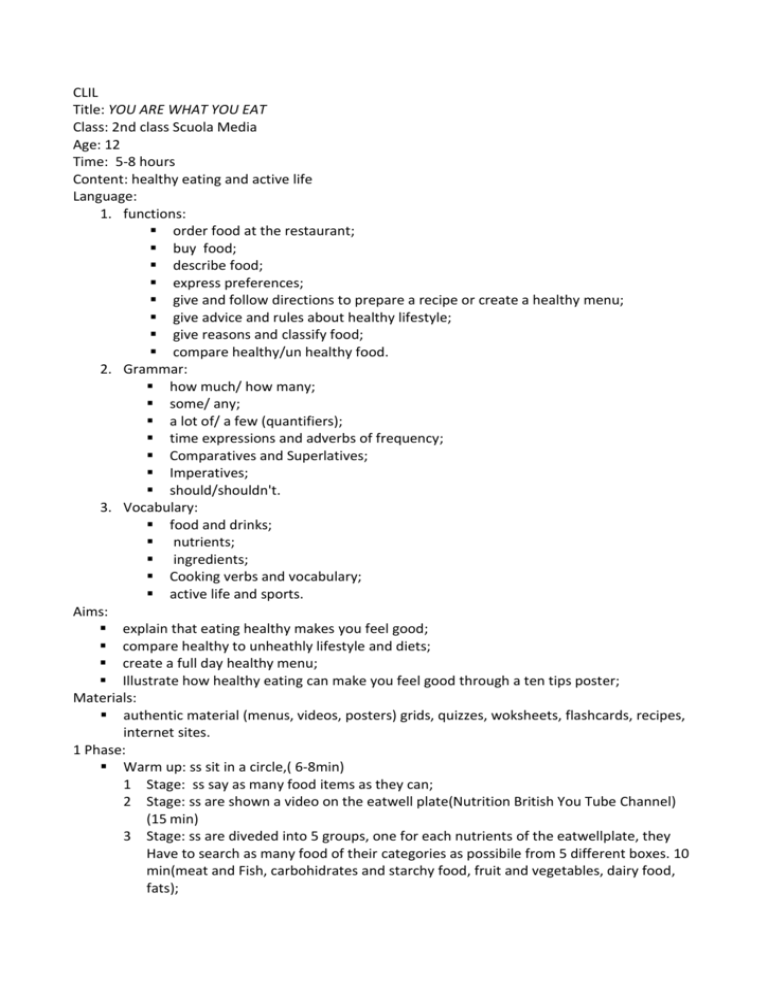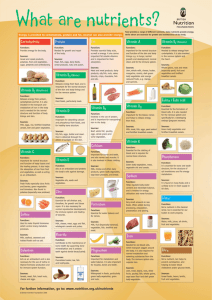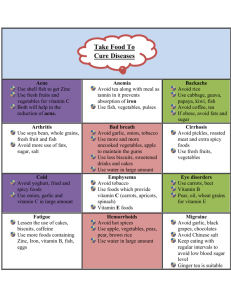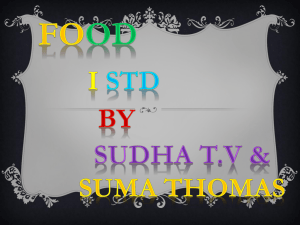Activities - istituto Comprensivo Nord
advertisement

CLIL Title: YOU ARE WHAT YOU EAT Class: 2nd class Scuola Media Age: 12 Time: 5-8 hours Content: healthy eating and active life Language: 1. functions: order food at the restaurant; buy food; describe food; express preferences; give and follow directions to prepare a recipe or create a healthy menu; give advice and rules about healthy lifestyle; give reasons and classify food; compare healthy/un healthy food. 2. Grammar: how much/ how many; some/ any; a lot of/ a few (quantifiers); time expressions and adverbs of frequency; Comparatives and Superlatives; Imperatives; should/shouldn't. 3. Vocabulary: food and drinks; nutrients; ingredients; Cooking verbs and vocabulary; active life and sports. Aims: explain that eating healthy makes you feel good; compare healthy to unheathly lifestyle and diets; create a full day healthy menu; Illustrate how healthy eating can make you feel good through a ten tips poster; Materials: authentic material (menus, videos, posters) grids, quizzes, woksheets, flashcards, recipes, internet sites. 1 Phase: Warm up: ss sit in a circle,( 6-8min) 1 Stage: ss say as many food items as they can; 2 Stage: ss are shown a video on the eatwell plate(Nutrition British You Tube Channel) (15 min) 3 Stage: ss are diveded into 5 groups, one for each nutrients of the eatwellplate, they Have to search as many food of their categories as possibile from 5 different boxes. 10 min(meat and Fish, carbohidrates and starchy food, fruit and vegetables, dairy food, fats); 4 Stage: after the game, ss Have to stick their food on a triangle to complete an eatwell plate. (10 min) 5 Stage: Ss compare their plate with the Nutrition poster ( 5 min) 6 Stage: Ss make a food pyramid according to daily portions needed per Day; 2 groups; 3 groups work on creating a grid to classify 8 different kinds of food (meat, Fish, dairy, fruit, veggy,...(high spirits 2 as example) (35-40 min) use of di dictionary allowed. 7 Stage: ss learn to classify food according to adjectives to describe taste, shape, color, texture. They can use a set of adjectives to complete the chart Oval round red yellow sour bitter juicy crunchy chewy... Food Orange Strawberry Hamburger Taste Shape Delicious Salty/fatty Triangular Housework: 1 make a survey on your weekly eating habits What do YOU BREAKFAST BREAK usually Have for... MONDAY Color Orange Texture Juicy Chewy LUNCH BREAK DINNER TUESDAY WEDNESDAY THURSDAY FRIDAY SATURDAY SUNDAY Here is the list of food they can choose from: Breakfast: Milk, milk & chocholate/coffee, tea, juice, cappuccino, coffee, yoghurt, homemade cake, croissants, biscuits, cereals, bread/toast/ rusks & Nutella/marmelade/ jam, fresh fruit. Snack: fruit, crisps, sandwich/ciabatta/roll bread with ham/ cheese/salami/ Nutella/jam, cakes, pizza, crackers, pop corn, pastries, chocolate bar, nuts, tea, juice, water, ice cream, energy drink, soft drink(Coke, Fanta, Ice tea) Lunch: pasta, rice, pulses, soup, meat, fish, vegetables, chips, fruit juice/ soft drink, sandwich, bread, green salad, pizza, kebab. Dinner: as lunch. 2. Make a survey on your life style How often Always Usually Often Sometimes Rarely do you Every day 4-5 Times 3 Times Twiice a Once a in a week in a week week week Walk to school Ride a bike Play a sport Play computer games Play active computer games Watch tv Tidy your bedroom Go for a walk Use social networks Help with the housework Go to the Never Others Go hiking Go to the gym Help with the housework Use social networks Go for a walk Tidy your bedroom games Watch tv Play Active computer Play computer games Play a sport Ride a bike Walk to school Activities gym Dance Go hiking Others Phase 2 1 stage: ss report their eating habits and lifestyle; 2 stage: teacher complete a chart with results; 25+... 20 15 10 5 0 at the end ss and teacher complete a diagramm with results to Point out good and bad habits, then asks ss: What’s your favourite meal of the Day? What’s the most important meal in your family? Do think your habits are healthy or unhealthy? What can you do to get a healthy life style? Phase 3 1 Stage: ss watch a video on Be Active, then complete a text with missing information(fill in, match, multiple choice) from the video. http://www.foodafactoflife.org.uk/attachments/f18c5b4b-d0f3-4d812bae87cb.ppt http://www.foodafactoflife.org.uk/attachments/b664ed68-d28a-448b001dee19.ppt 2 Stage: ss compare their life style with the information from the video/ watch a video find out for food (Nutrition british Channel on YOU tube) http://www.foodafactoflife.org.uk/attachments/f18c5b4b-d0f3-4d812bae87cb.ppt 3 stage: ss watch a posters (food a fact of life site) on nutrients and compare with their habits What are nutrients? Food provides a range of different nutrients. Some nutrients provide energy, while others are essential for growth and maintenance of the body. Energy is provided by carbohydrate, protein and fat. Alcohol can also provide energy. Carbohydrate Function: Provides energy for the body. Sources: Cereal and cereal products, potatoes, fruit and vegetables, sugar, preserves and confectionery. Protein Function: Needed for growth and repair of the body. Sources: Meat, fish, eggs, dairy foods, cereal products, nuts and pulses. Fat Function: Provides essential fatty acids, as well as energy. It also carries important fat soluble vitamins and is important for their absorption. Sources: Meat and meat products, dairy products, oily fish, nuts, cakes, biscuits, crisps, chocolate, fats and oils. Vitamin B3 (Niacin) Function: Releases energy from food, and is important for the normal structure of the skin and body linings and for the nervous system. Sources: Most foods, particularly meat. Vitamin B2 (Riboflavin) Function: Releases energy from protein, carbohydrate and fat. It is also involved in the transport and metabolism of iron in the body and is needed for the normal structure and function of body linings and skin. Sources: Milk, eggs, rice, fortified breakfast cereals, liver and green vegetables. Vitamin B6 Function: Involved in the use of protein, and is important for transporting iron in the body. Sources: Beef, white fish, poultry, eggs, whole grains and some vegetables. Vitamin A Function: Important for the normal structure and function of the skin and body linings e.g. in lungs; normal growth and development; normal vision and for the immune system. Sources: Liver, whole milk, cheese, butter, margarine, carrots, dark green leafy vegetables and orange coloured fruits, e.g. mango and apricots. Vitamin B1 (Thiamin) Function: Needed to release energy from carbohydrate. It is also involved in the nervous system and the heart. Sources: Whole grains, nuts and meat (especially pork), fruit and vegetables and fortified breakfast cereals. Folate / Folic acid Function: Essential for the formation of blood cells. It is also needed for the nervous system and specifically for a developing embryo (pregnant women). Sources: Green leafy vegetables and fortified breakfast cereals. Vitamin D Function: Important for absorbing calcium and phosphorus from foods, and for healthy bone structure. Sources: Oily fish, eggs, butter and meat. Most is obtained through the action of sunlight on the skin. Vitamin B12 Function: Important for the blood, nerves and helps to release energy from food. Sources: Milk, meat, fish, eggs, yeast extract and fortified breakfast cereals. 4 Stage: ss work out a poster with ten tips on how to Have a healthy life style Phase 4 1 stage: ss Role play on authentic menus; they are divided in 3 groups: breakfast, lunch, tea time: they Have to order the best meal on the menu (photocopies from Boston Tea party/ pub) according to what they Have learnt about fats, proteins etc.... Home work Ss Have to create and ideal menu and count nutrients; teacher gives them a grid with fats, sugar...etc and they Have to count the right amount of each nutrients per meal(breakfast, lunch, tea, DINNER time) use models in photocopies 2 Stage: ss make an ideal menu per group Phase 5 1 stage: ss watch a video recipe, read a funny healthy recipe; 2 Stage: ss give instuctions, ingredients and quantities, they explain the procedure of their own ideal healthy recipe.



